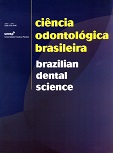Avaliação da densidade radiográfica de defeito periodontal em suínos utilizando imagem digital
DOI:
https://doi.org/10.14295/bds.2007.v10i1.420Abstract
A imagem digital tem sido utilizada como um importante recurso diagnóstico na Odontologia. A dificuldade no diagnóstico dos defeitos de furca desperta particular interesse, visto que o tratamento está relacionado à extensão do defeito ósseo. Além da qualidade da imagem, a habilidade do observador é essencial para o diagnóstico. Recurso técnico como a densidade poderia auxiliar na análise comparativa das imagens do mesmo defeito, entre os períodos de observação. O objetivo deste estudo foi avaliar a densidade radiográfica como auxiliar na determinação da extensão de defeitos de furca. Foram criados 24 defeitos de furca em dente birradicular mandibular de suínos, com profundidade crescente, numa seqüência de remoção óssea simulando envolvimento de furca grau I, II e III; sendo obtidas imagens digitais a cada passo. Determinou-se a média de densidade dos defeitos (inicial, grau I, grau II, grau III), num total de 96 imagens. Com os valores obtidos foi realizada análise de variância e teste de Tukey para comparação entre os graus de envolvimento de furca. Houve diferença significativa (p<0,001) entre os defeitos: inicial e grau I, II e III; grau II e III. Não houve diferença significativa apenas entre os defeitos grau I e II (p>0,05). A média de densidade para os grupos foi: inicial - 126,98; grau I - 112,52; grau II - 106,22; grau III - 80,63. Concluiu-se que a densidade radiográfica pode auxiliar na quantificação de defeito de furca, constituindo recurso adicional à habilidade do observador.Downloads
Downloads
Published
How to Cite
Issue
Section
License
Brazilian Dental Science uses the Creative Commons (CC-BY 4.0) license, thus preserving the integrity of articles in an open access environment. The journal allows the author to retain publishing rights without restrictions.
=================




























